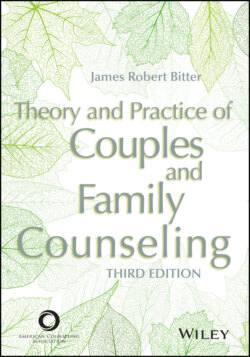Читать книгу Theory and Practice of Couples and Family Counseling - James Robert Bitter - Страница 83
Toward a Foundation for Integration
ОглавлениеWhat I suggest in this book is that each theory or model brings certain perspectives to the practice of family counseling. One way to create a foundation for the integration of these models is to look at what we can learn by developing perspectives, assessments, and interventions across the various approaches. In 1992, Breunlin et al. (1997) introduced the concept of metaframeworks as a method for transcending the various approaches to family therapy. This model was recently updated by Pinsof and associates (2018). They identified five pillars to integrative systemic therapy and seven metaframeworks that are treated as core perspectives. I address this model more thoroughly in Chapter 18 on integration. For now, I simply want to note the seven perspectives or lenses that inform their model:
1 Organization of systems
2 Developmental processes (in individuals, families, and macrosystems)
3 Cultural perspectives
4 Mind as an avenue into internal experiences
5 Gender perspectives
6 Biology, wellness, and mental health
7 Spiritual perspective
I like to think of each metaframework as a different lens through which I can meet, learn about, and come to understand a family. With these seven lenses, Pinsof and associates (2018) provide a means of assessing families across models and developing multiple avenues for intervention in their “blueprint for therapy” (pp. 79–98). I recommend that you head to Chapter 18 on integration and read the description of each of the seven lenses provided there. You can read the chapter in detail later on.
As you read the theory chapters in this book (Part 2), think about what the various models might contribute to each of the seven lenses. I occasionally note certain contributions to these perspectives in the theory chapters, but you may discover contributions I have not mentioned. In my own work, the five pillars and seven lenses provide me with richer understandings and family descriptions than I would have using only one perspective. At various times, I use some lenses more than others. In most cases, the family members and the issues presented just seem to fit one subset of perspectives better. It is not uncommon, however, for me to consider all seven lenses at least initially. Any or all of them may have meaningful applications during the therapy process. As Pinsof et al. (2018) noted, there is a recursiveness to these perspectives, with each lens influencing and being influenced by the rest. The advantage of using these lenses in family practice is that they provide multiple perspectives for assessment as well as means for tailoring therapeutic interventions to the specific needs of the family (Carlson et al., 2005; H. Goldenberg & Goldenberg, 2002; I. Goldenberg et al., 2017). I believe that the seven metaframeworks provide a foundation for integrating most of the approaches that make up this book.
